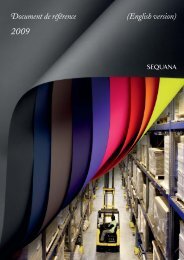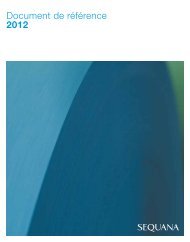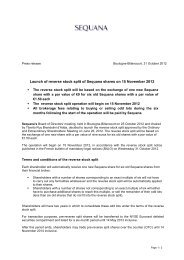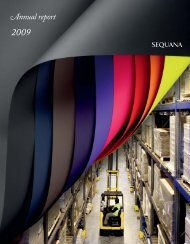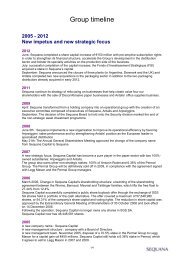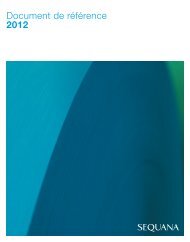Contents
Registration document PDF - Sequana
Registration document PDF - Sequana
Create successful ePaper yourself
Turn your PDF publications into a flip-book with our unique Google optimized e-Paper software.
Financial position – resultsNotes to the consolidated financial statements 4B8 - Property, plant and equipmentProperty, plant and equipment are stated at (historical) cost,less any accumulated depreciation and impairment losses. Costincludes the acquisition cost and all costs directly attributable tothe asset’s acquisition or development, transfer to the location ofuse and preparation in order to enable it to operate in the mannerintended by management.Components of property, plant and equipment with differentuseful lives are recognised separately.Expenditure related to the replacement or renewal of a componentof an item of property, plant and equipment is recognisedas a separate asset and the replaced asset is derecognised. Othersubsequent expenditure relating to an item of property, plant andequipment is not recognised in assets unless it is probable thatthe future economic benefits associated with the expenditure willflow to the entity and the cost can be measured reliably. All othersubsequent expenditure is expensed as incurred.Regular maintenance costs relating to items of property, plantand equipment (cost of labour, consumables and small spareparts) are also expensed as incurred.Bridging interest charges or construction period interest chargeson assets that take a substantial period of time to get ready fortheir intended use (“qualifying assets”) are capitalised. However,borrowing costs are generally expensed as incurred as the natureof the Group’s business is such that it acquires or manufacturesvery few “qualifying assets”.Revaluations made in accordance with local accounting standardsin the countries in which the Group operates are eliminated.With the exception of land, property, plant and equipmentare depreciated from the time that the assets are ready for use.Depreciation is calculated on a straight-line basis over the followingestimated useful lives:■■buildings■■industrial machinery and equipment■■other property, plant and equipment10 to 40 years5 to 20 years3 to 25 yearsDepreciation methods, residual values and useful lives arereviewed at least at the end of each reporting year and more oftenif there is an indication of impairment.An impairment loss is recognised if an asset’s estimated recoverableamount is lower than its carrying amount. Impairment losseson property, plant and equipment may be subsequently reversedwhere appropriate.Government grants used to partially or wholly finance the costof an item of property, plant and equipment are recognised asa liability under “deferred income” and recycled to the incomestatement on a systematic basis over the useful life of the correspondingasset.B9 - Non-derivative financial assetsInitial recognitionPurchases and sales of financial assets are recognised on the tradedate corresponding to the date on which Sequana commits topurchasing or selling the assets.Financial assets are derecognised when the contractual rights toreceive the cash flows from the assets have expired or have beentransferred, and the Group has transferred substantially all risksand rewards of ownership to another party without retainingcontrol over the asset.Financial assets are initially recognised in the statement of financialposition at fair value plus transaction costs directly attributableto the purchase or issue of the asset (except for financialassets at fair value through profit or loss, whose transaction costsare recognised in profit or loss).A financial asset is classified as “current” when the cash flowsexpected to be derived from the instrument are due within12 months after the end of the reporting period.Subsequent measurementAt initial recognition, the Sequana Group classifies financialassets into one of the four categories provided for in IAS 39 –Financial Instruments: Recognition and Measurement, dependingon the purpose for which they were acquired. The assets aresubsequently measured at amortised cost or fair value dependingon their classification.Amortised cost is the amount at which the financial asset ismeasured at initial recognition minus principal repayments, plusor minus the cumulative amortisation using the effective interestmethod of any difference between that initial amount and theamount payable at maturity.The fair value of instruments quoted in an active market correspondsto their quoted market price. The fair value of instrumentsthat are not quoted in an active market is determined using valuationtechniques including recent arm’s length market transactions,reference to a transaction that is substantially the same,or discounted cash flows and option pricing models, using datainputs based on observable market transactions wherever possible.If it is impossible to reliably estimate the fair value of anequity instrument it is stated at historical cost.The categories of financial assets used by the Group are as follows:■ ■ held-to-maturity investments: non-derivative financial assetswith fixed or determinable payments and fixed maturities thatthe Group has the intention and ability to hold until maturity.They are measured at amortised cost and any impairment lossesare recognised through profit. For the Group, held-to-maturityinvestments comprise security deposits, seller loans and certainfinancial loans;Sequana | 2012 Document de référence (English version) | 103



